
|   |

|   |
 e-mail: sunilkothari1933@gmail.com Nritya Sanrachna: A festival of choreographic works Photos: Dr. Sunil Kothari April 14, 2017 Under the aegis of Sangeet Natak Akademi, Jawaharlal Nehru Manipuri Dance Academy and Manipur University a festival of choreographic works by leading dancers and choreographers from different states of India was arranged at Imphal from 22nd till 26th March 2017 at the new Maharaja Chandrakirti Auditorium, Manipur University. I missed first two days' performances of Sharmila Biswas and her artists of Odissi Vision and Movement Centre, Kolkata, who had presented new work Trividh, a revival of choreographic work of legendary late Raj Kumar Priyogopalsana of Imphal, viz., Kabui-Kei-Oiba, and Prathibha Prahlad's Silk Sutra. I had recently seen Vanashree Rama Rao's Kalpakatha, dramatic tales from mythologies, at Khajuraho Dance Festival. On 24th March, I caught up with choreographic work of Guru Jatin Goswami from Guwahati. In its solo rendering I had seen story of Ekalavya at Nishagandhi Festival at Trivandrum by Dr. Lima Das. In group choreographic work, the characters of five Pandavas and Guru Dronacharya were etched out well to create appropriate dramatic impact. In hands of veteran guru Jatin Goswami, the Sattriya dance form has acquired sophistication and stage worthy presentation. In one of the seminars on Sattriya dances at Guwahati, Jatin Goswami had mentioned the concept of shruti ranjan and drishti ranjan. The music should be pleasing to the ears and dance should be pleasant for the eyes. Though Sattriya dance has been preserved thanks to the institution of Sattras (monasteries) in Assam, the performances taking place in monasteries indeed have a different orientation of bhakti. When its transition takes place on a metropolitan proscenium stage, the dramatic element comes to the fore. Jatin Goswami, keeping the aesthetic elements of rasa, manages to make it accessible to contemporary urban audiences. In the beginning to give a flavor of nritta of Sattriya, the six female dancers performed Behar nach. Using the basic stances and alphabets, Jatin Goswami has brought a narrative of Ekalavya, which moves smoothly. Since the story is well known and with libretto in Brajabuli with comprehensible Sanskrit, Brijbhasha and almost Hindi words, he has with choreographic touches, shown entrances of five Pandavas along with Guru Dronacharya from whom they want to learn art of archery. Ekalavya is also anxious to learn from Dronacharya, but since he is of low caste, he is denied the privilege. He makes an image of Dronacharya and learns the art of archery surpassing even the excellent training received by Arjuna. Once Ekalavya found that a stray barking dog was creating nuisance. With sabdavedhi arrow, he shot it at the dog, whose jaw was locked without hurting the animal. When Dronacharya came to learn about it he was surprised. Knowing that it was Ekalavya, whom he had refused to teach archery, Dronacharya seeks to retain Arjuna's status as supreme archer and asks Ekalavya for guru dakshina, the thumb of his right hand. Without any hesitation Ekalavya cuts it and offers it to Dronacharya. All are aghast seeing this. In the production, Jatin Goswami has given these final touches. Despite having cut off his right thumb, Ekalavya is able to shoot an arrow. The contemporary meaning invested in the production is moving. Today the low class community need not be treated in this manner. The production succeeds in conveying this message. Dr. Lima Das, disciple of Jatin Goswami, excels in role of Ekalavya. Earlier it was in role of Draupadi that Lima Das had received encomiums. Now Ekalavya has become her favorite role. With expressive face registering varied emotions Lima Das conveys the agony of a low class young man and generously offers the thumb, knowing well what his Guru Dronacharya demands. The story touches chords of our hearts. The entire troupe performed well with good synchronization of pure dance, creating an overall pleasant impact. The costumes and music were highly aesthetic. 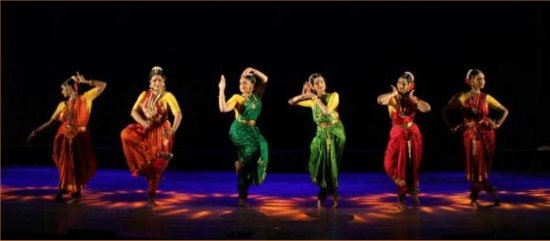 Geeta Chandran and Natya Vriksha ensemble Photo courtesy: Geeta Chandran From Delhi, Geeta Chandran with her Natya Vriksha ensemble presented Natya Vrinda. In costumes designed by Sandhya Raman with pleasant colours and commendable lighting by Milind Srivastav, the group of six dancers struck excellent impression with a novel approach to alarippu, dividing into three groups, sometimes four dancers gently clapping the palms and reciting the mnemonics of alarippu, others performing movements, deconstructing alarippu which wore a new look - it was a visual delight. As a dance form, how Bharatanatyam offers space and scope for an imaginative choreographer was brought home to audiences which consisted of local Manipuri dancers. The sounds of ghatam, drums, mridangam, lent delectable texture. What followed in terms of music and movement titled Swarna Raga Sudha using in the beginning solfa sa ma, ni dha wove a soundscape that was enchanting. Geeta with imaginative recording artist brought an effect of echoes of solfas in which the sounds melted along with movements. At times three dancers formed a group, creating triangles, and executing clean lines, horizontals and diagonals, inwards and outwards, Geeta joins them and all form arresting patterns. The dancers were bathed in shower of light that showed them in visually stunning moulds. With collaboration of that melodious vocalist Sudha Raghuraman, Geeta and Sudha's approach to this musical composition with unusual choreography was sheer delight. The well trained dancers offered uniformity and symmetry, the hallmark of Bharatanatyam. And when in Manipur, with presiding deity Govinda ji, Geeta mentioned that she had to perform the Rasalila, to the song of Hari Hitavamsha's composition Khelat rasa rasik vrajamandala. Krishna in his innumerable ways plays rasa with gopis. Geeta when describing Sharada vimal nabha Chandra birajat, how the moon shines in spotless sky evoked the beauty of the moonlight. The magic of Krishna's flute, listening to which animals, birds, creepers, trees, waters of river Yamuna, gopis, are in a trance. The finale in which the group took various tableaus describing the effect of Krishna's flute was exquisite and kaleidoscopic. The mood for celebration was infectious. No wonder the rasik devotees of Govinda ji applauded this enjoyable presentation. Geeta's disciples Dibya Saluja, Amrithashruthi Radhakrishnan, Radhika Kathal, Madhura Bhrushundi and Akanksha Kumar performed with professional approach, high standard of technique and faultless synchronization. Milind Srivastav's lighting deserves special mention. The third presentation was again a revival of an old choreographic work by late Guru Th. Babu Singh for Jagoi Marup group. Titled Ashta Nayika, to represent the state of mind of nayika vis-à-vis her beloved, the character of Radha was chosen. Opening scene showed eight dancers in various poses and moods and later on the narrative unfolded. Since the libretto was in Meitei language, only with angikabhinaya one was able to grasp the particular state of Radha. The Kunj, bower of Brindavan, was suggested by two arches on either side. Since the theme related to Krishna and Radha, traditional composition like Radha abhisara was depicted. Radha wears green lower costume and other gopis wear different colour. Chandrabali wears blue scarf. Radha is seen with other gopis plucking flowers to prepare bed, prepare garland, also to decorate the space. The song suggests Radha as Vasaksajjika nayika, putting on ornaments and awaiting her lord. 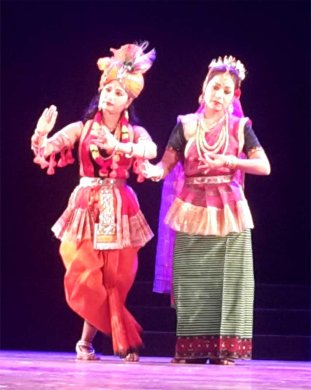 Ashta Nayika The script written in earlier years did not look coherent. For, there were sequences of young boys dressed as Krishna and his friends performing, playing game of ball, Kanduk khel. Radha's anguish was enacted through singing in high pitch, suggesting her state of helplessness. The program note given scene wise was not very useful. Radha was given signal for meeting by Krishna, which when she saw him going with Balaram, she could not follow. The third scene was comprehensible when sakhis and Radha were decorating the Kunj. In the following sequence, Radha asks Krishna to leave her as she was upset on his not arriving in time as promised. She then regrets having asked Krishna to leave. Sakhis console her, but her agony knows no bounds. She asks them to go unto Krishna and bring him. There we see a procession in which maternal uncle Akrur, is shown taking Krishna and Balaram to Mathura. Radha is further depressed and agonized. In following sequence, once again we see Radha lamenting. Sakhis go and urge Krishna to meet Radha. Therefore, one gets confused as to when did Krishna return and the sakhis speak to him? In the end we are shown Radha and Krishna united and sakhis bring aarati and chowries and offer prayer. The production under review was directed by Th. Bimola Devi. Dancers from Manipuri Jagoi Marup group including female exponents G. Asha Rani, M. Rita Devi, Th. Lembi Devi and others and among male dancers H. Sudhirchandra Singh, N. Prabin Singh and others performed competently whatever roles they were assigned. The vocal music by P. Sanahanbi Devi and N. Usharani Devi was as per the traditional norms along with other musicians playing pena, pung, sarod, flute and violin. In order to make the work accessible without changing original choreography, the sequences should be made comprehensible so the theme of Ashta Nayika could be justified. The state of nayika needs to be established so that all eight states in which Radha finds herself in relation to Krishna could be vividly seen. On 25th March, the opening performance was by Sangeeta Das and her disciple Aneesh Raghavan in Odissi of Guru Deba Prasad Das's style. Sangeeta is a seasoned disciple of Deba Prasad. She re-choreographed the original Ganesh Nritya in a format in which it enhances the tandava aspect of Ganapati's dance. His attributes, eka danta, one tusk, mahakaya, large body, lambodara, with big tummy and waving ears, riding over his mouse vehicle were enacted with finesse. The traditional song Tandava nritya kari Gajanana lent lot of regional flavor. Both Sangeeta and Aneesh Raghavan performed with appropriate touches creating iconic images of Ganapati. Pallavi in Ananda Bhairavi raga and tishra triputa tala by both the dancers was danced in joyous mood, bringing to the fore the inherent beauty of pallavi. The parshava mardala hasta, the placing of ornaments, the symmetrical poses, like mirror images et al were in admirable sync. The gradual increase in tempo was pleasant as the movements were kept clear. The formal beauty of the choreography was maintained well. Gita Govinda ashtapadi Yahi Madhava yahi Keshava by Sangeeta saw her depicting Radha's agony at Krishna's truant behavior, arriving at break of dawn, having played with other gopis, in a dignified and restrained manner. Radha's character as Uttama nayika demands an understanding on part of dancers not to show her in extreme anger and demanding Krishna to leave. Instead seeing him with telltale marks, an agonized Radha begs Krishna to leave her and not to tell lies. The abhinaya has to convey mood of khandita nayika with dignity. Sangeeta did justice to the character. Solo abhinaya piece by Sangeeta saw sakhi of Radha teasing her and not allowing her to go to Jamuna to meet Krishna. Na ja Jamuna is a delightful Odiya song giving scope to a dancer to bring mischief and element of fun to depiction of what Krishna would do if Radha were to go alone to Jamuna. His pranks were enacted to dissuade Radha to go to meet him. Rajiv kunj nayana phrase was repeated with lilting refrain. The concluding number Moksha performed by both of them ended with shloka Asato ma sat gamaya bringing feeling of peace. Sangeeta Das and Aneesh Raghavan displayed the bani of Debaprasad Das faithfully. However, if more artists were a part of Sangeeta's troupe and new choreographic works were brought to the festival, it would have helped to project Guru Smaranam in its richness. From Hyderabad, the renowned female impersonator Kala Krishna and troupe gave a superb exposition of Andhra Natyam, which his guru late Nataraja Ramakrishna spent his entire lifetime to establish in its glory. Kala Krishna is a worthy successor of the late guru. Having studied from Saride Manikyamma, Annabatula Satyabhama, Jampa Muktyama he later specialized in the art under Nataraja Ramkrishna. He further studied Kuchipudi under Jagannadha Sarma and Vempati Chinna Satyam, and Bharatanatyam under G. Visalakshi. As performer of temple dance he established himself and received critical appreciation for Navajanardhana Parijatam, traditionally performed over nine nights in the temples of East Godavari District of Andhra Pradesh. Recently after the division of Andhra Pradesh into Telangana State and Andhra Pradesh, Telangana State Government has entrusted him to prepare and reconstruct Perini dance form, which he is busy with. 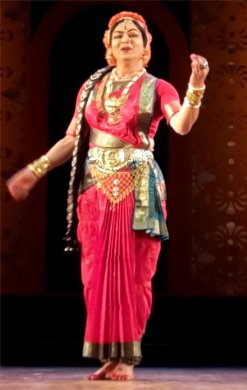 Kala Krishna 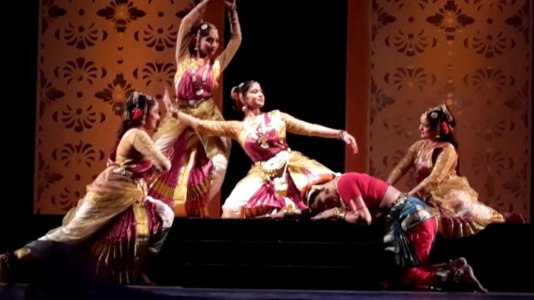 Kala Krishna's troupe With his four female dancers he opened the performance in streevesham with Pushpanjali holding Kumbharati in hand behind a curtain, in style of temple rituals, and followed by Ashta Dikpala Kaivaram in praise of the caretaker of the eight corners of the temple, viz., Indra, Agni, Yama, Nairuti, Varuna, Vayu, Kubera and Ishani. There were interesting group formations on the presiding deity of each direction to whom the devotee offers prayers. The use of higher level of platform as a part of temple gate was imaginative. In Navajanardhanashtakam of Rudra Kavi in patra pravesh daru he came into his inimitable style with female graces, nuances, and subtle expressions creating an array of emotions that were mesmerizing. Satyabhama's pride, swadhinapatika character, exquisite beauty and display of feminine graces were enacted with consummate artistry. In sequences that followed as a nayika, receiving the beloved, when she found him with telltale marks of having spent time with another woman, with his eyes red, not having slept but dallying with other woman, asking him to uncover the shawl with which he had covered his chest and showing him how he was being kissed all over that not even a needle can be placed anywhere, she chided him with agony. The abhinaya was moving and becoming a woman being hurt. As Satyabhama, who is a vira Vanita, bold and able to stand on her own, Kala Krishna showed range of his emotions in a delectable manner. The rasanubhuti was achieved with mastery over his art and experience of having performed for more than 30 years. His four disciples acquitted themselves well providing commendable support. Next morning since there was a total bandh in Manipur, in the morning instead of at Manipur University, at the hall on the fourth floor of the Classic Hotel, Kala Krishna and his four disciples gave a lucid lec dem on Andhra Natyam, showing distinction between it and Kuchipudi. Kala Krishna demonstrated how he has been reconstructing Perini dance form drawing references from several Sanskrit texts on dance. It was most illuminating. In particular, Kala Krishna performed one padam similar to Kshetraiyya's Evade vadu (who was he?) but ascribed to Parthasarathy and showed various sanchari bhavas on the spot which were exquisite. From Pushpabanavilasamu, how the shloka with its separate words are interpreted showing its inner meanings, and how it varies from Kuchipudi. The references to three reasons why Krishna left Satyabhama, when looking into the mirror and bragging that she was more beautiful in form than Lord Krishna, second she was stronger than him in strength though Krishna was known to have lifted Govardhana, she counter arguing that she in love play holds him on her body and the third one that when asked in kamakeli, love foreplay, to strike him with jata, she does not respond - these nuances were explained with care. In recreating the nritta aspect of Perini he asked the disciples to demonstrate various sections like gharghra, vishama, kaivara, six steps chavada, parivaram, samayati vinyasa, kalahudam, alagnapata, patvam, jump and so on. It was quite fascinating to see the process of recreation of the form. It seems that on the scene at the moment in absence of his late Guru Nataraja Ramakrishna, he is the only one who can be entrusted with these responsibilities. Renowned Bharatanatyam guru C.V. Chandrasekhar suggested that he needs to establish some basic position of the form. Perini has tandava element and heroic mood. The footwork is similar to tatkar of Kathak also. Once the basic vocabulary is established with his talent Kala Krishna is bound to recreate the Perini form. The morning session of lec dems at the Manipuri University was an important aspect of the choreographic dance festival. The ones given by Sharmila Biswas and Vanashree Rama Rao were much appreciated. At present with two Manipuri dancers Lilavati and Tejavati trained at Kalakshetra, optional subject Bharatanatyam is offered in the University. It augurs well for young dancers specializing in Manipuri and choosing optional Bharatanatyam. Such lec dems offer them insight into treasure troves of our classical dance forms. In the evening the opening was by Raipur gharana Kathak guru Ramlal Bareth's disciples. It was brief and dwelt essentially on Raipur gharana bandishes, as penned by Raja Chakradhar Singh, who himself studied Kathak from Jailal of Jaipur gharana and also had in his court gurus of stature of Acchan Maharaj and Shambhu Maharaj of Lucknow gharana. It is an important phase in the history of development of Kathak in immediate pre-and post independence era. Ramlal also studied from his father Kartikram, who had benefit of studying from the legendary gurus of Jaipur and Lucknow gharanas. During my researches and field work I had visited Raigarh in early seventies and photographed Kartikram, Firtu Vaishnav, Barmanlal, the repositories of Raigarh school of Kathak. I also visited Khairagarh University and recorded history of Kalyan Mahant whom Raja Chakradhar had trained in Kathak. The repertoire of Raigarh presented by young disciples of Ramlal viz., Dr. Rakhi Dubey (now settled in Haryana), Priyanka, Anchal Pandey and Tanya consisted of Shiva stuti in Shankara raga and in drut laya. The four dancers performed it with feeling to the singing of the prayer Bhasamangaragaya Trilochanaya, Mahadev Shiva har hara. It was followed by tigalbandi, three dancers performing nritta, gat nikas, paran et al with old world charm. The gat nikas with murali, bindi, husna were executed well. But overall the impression created was rather lack of practice and perfect coordination. The dancers should have practiced more to evoke the images of Raigarh repertoire. The composition of Raja Chakradhar for abhinaya was interesting. Gori saloni tore nayana naval madamat naval rup - O beautiful maiden, your eyes generate intoxication, and like arrow they pierce the hearts of the lovers. The dancers attempted to present it with abhinaya which could have been seen in better frame with elaboration. The one which depicted navarasa was interesting from the point of Raja Chakradhar wanting to capture the emotions in one song. However, the projection lacked enough depth. The paran for Badal bijli gave a partial glimpse of the rich repertoire. But the song Jhama jham pani barsat, vidyut chamakat, and with mnemonic syllables for davanal, the dry leaves catching fire were rare ones. Based on raga Desh, and considered the piece de resistance Chandrabadan mrigalochini, damini dyuta, gori albeli naval nari, karat chitta ki chori- the maiden with moon like face, eyes like those of a deer, resplendent like lightning, stealing hearts of the lovers, when she goes to meet beloved, her ankle bells ringing, carrying a plate with lamps, walking with gait of an elephant, and raising the eyebrows which shoot arrows, was rich from literary point of view and could have offered enough scope if the dancers were trained well. Guru Ramlal Bareth conducted the program with recitation of bols for kavits and nritta, whereas his son Bhupendra Bareth played on tabla, Dibakar sang songs and Amrish Gangarde played sitar. Though the aim by SNA was to encourage Raigarh tradition and bring it in mainstream, on account of lack of practice on part of dancers, the aim did not meet with success. In future, these artists need to be guided well to be aware of present day Kathak dance scene. From Trissur, Kerala, the celebrated Mohiniattam exponent Kshemavati brought her troupe choreographing Krishna Katha. Kshemavati was trained in Mohiniattam by legendary Chinnammu Amma and Satyabhama from Kerala Kalamandalam. Therefore, her choreography revealed an authentic stamp. Dr. Min Pramod, Reshmi Menon, Anjali Balan, Salini P.S. and Veni P, all of them dressed in eye catching Mohiniattam traditional costume with hairstyle of bun on one side, looked impressive and performed with graceful movements weaving stories of Krishna. Beginning with Gita Govinda shloka in which Nandaraja tells Radha to take Krishna home as the sky was gathering clouds, and followed by Pralayapayodhi jale, dashavatara prayer, depicting ten incarnations, Kshemavati choreographed tableaus showing each incarnation clearly with group of four dancers. The most effective were tableaus of Narasimha and Vamana. Kalki was shown with rider drawing a chariot of four horses. The compositions were seamless and striking. The events of Poothana moksham, of showing Yashoda the brahmanda, of subjugating serpent Kaliya were dramatic and group dances flowed smoothly from one to another. The description of Krishna with garland and other ornaments evoked familiar images. The singing was melodious as were the percussion instruments. Kshemavati's choreography was pleasant, commensurate with the episodes of Krishna tales. 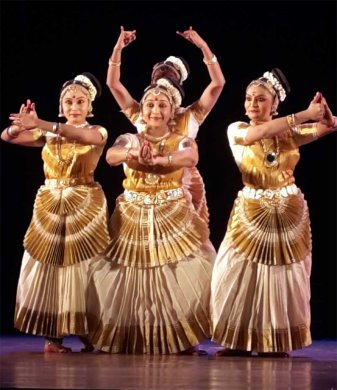 Kshemavati's troupe 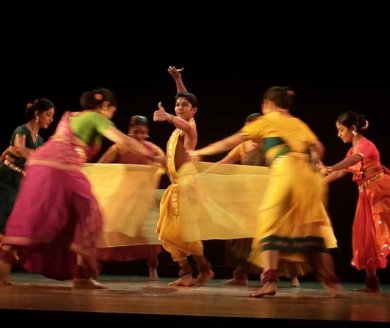 Ritusamhara The finale of C.V. Chandrasekhar's choreography of Kalidasa's Ritusamhara, binding of the six seasons in Bharatanatyam, first attempted in early 1980, when he joined as a Professor at M.S. University of Baroda looked fresh and evocative even after an interval of 35 years. He also composed the music with Hindustani ragas which were appropriate for the season chosen. He selected two seasons only, Grishma and Vasanta. Kalidasa in his exquisite Sanskrit poetry Prachanda Suryaha, Spruhaniya Chandrama, the contrast of burning sunlight and cool moonlight - the season showing its effect upon the animals, birds, human beings, finds felicitous expression with images of unparalleled beauty. Those who are enemies like peacock and serpent, stay with each other because of the wrath of sun, in the spreading of his feather casting shadow, the serpent takes refuge. The dancers created those images in a striking manner. A seasoned choreographer C.V. Chandrasekhar has created patterns of beauty, alignment of diagonal lines, coming together in the centre, dancers raising their arms, then spreading out and performing with uniform technique of chiseled movements. For Grishma the use of a variety of Sarang ragas like Brindabani, Shuddha, Gauda and Deshi were most appropriate. CVC is one of the rare musicians besides an accomplished dancer to use Hindustani music which is more easily appreciated in the North. He explained the background, how at Kalakshetra, Rukmini Devi used to invite Dagar brothers who during their residency exposed the students to the beauty of Dhrupad. All this, he said had helped him in shaping his taste for music exploration. Vasanta saw riot of colors. Dancers entered with colorful scarves, and waving them created heralding of Vasant, in which Manmatha with his flowery arrows creates longings in hearts of lovers for union. Pavanasugandhi ramya sarvam priye, dwiref parichumbita charupushpa, the wind fragrant generating pleasantness, and the bees kissing flowers generating desire among lovers, the images of bees sucking honey from flowers, dancers moving all over like buzzing flying bees and hastas turning into flowers were exquisite. The young maiden with her friends applying sandal paste, fanning her, to comfort her from the heat created by separation from beloved, and Manmatha dancing were striking images. The ragas Vasant, Kafi, Bahar, and Bhairavi were most appropriate for the season. The singing by renowned vocalist Hariprasad was melodious. The costumes for Grishma season of saffron color and for Vasant several colors were visually most aesthetic. The group of dancers Manjari Chandrasekhar, Renjith Babu and Vijna Vasudevan, Anusha Natarajan, Varsha Akhari, Prithvija Balagopalan and Meghana performed with elan, dignity and perfect coordination highlighting the concept of the choreographer and the poetry of Kalidasa. Bravo C.V. Chandrasekhar, for such exquisite treat of bhava, raga and tala. It was a fitting finale for the Nritya Sanrachna Festival. Helen Acharya, former Secretary of SNA, her entire team from SNA, the officers of JNMDA, and Manipur University, deserve congratulations for mounting such an ambitious festival, with audience consisting of gurus, dancers, scholars of Imphal attending the shows with enthusiasm.  Dr. Sunil Kothari is a dance historian, scholar, author and critic. He is honored with Padma Shri, Sangeet Natak Akademi award and Senior Critic Award from Dance Critics Association, NYC. Post your comments Please provide your name and email id when you use the Anonymous profile in the blog to post a comment. All appropriate comments posted with name & email id in the blog will also be featured in the site. |